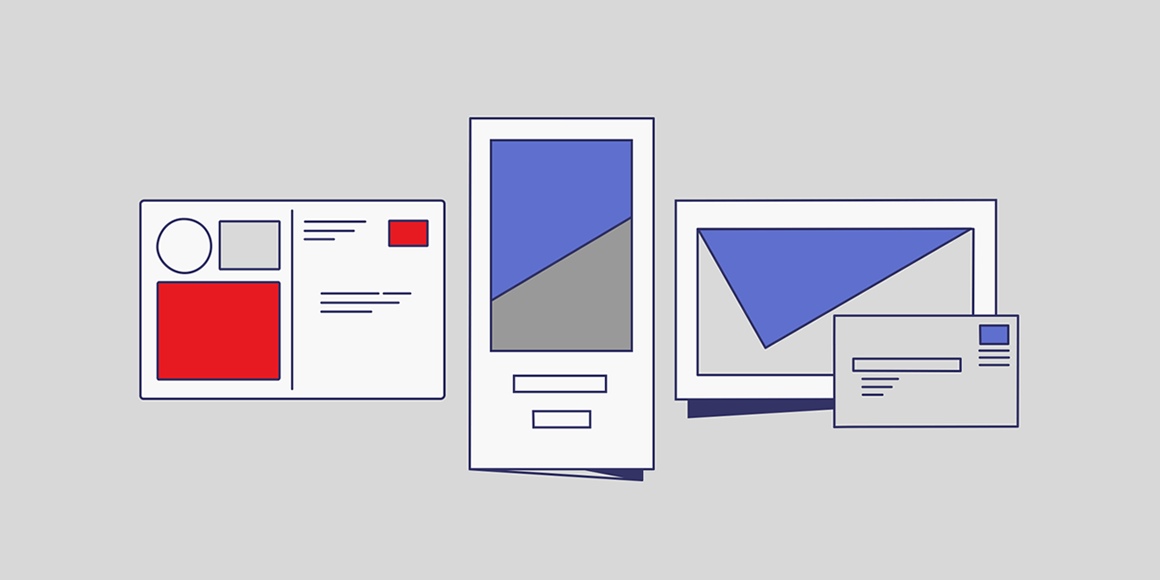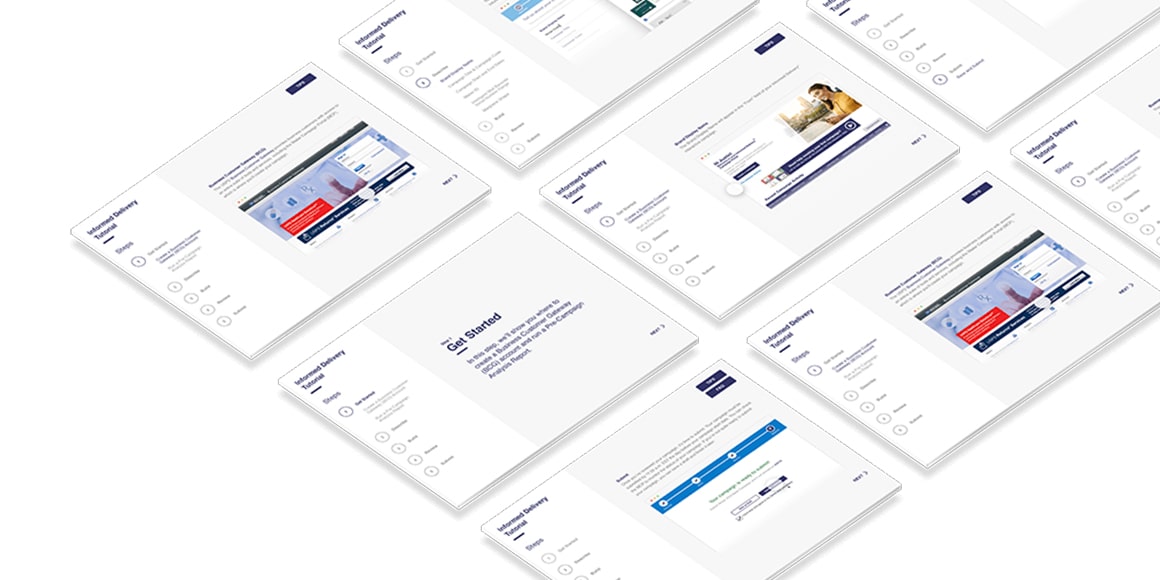
As COVID-19 continues to transform the way we do business, disrupting operations across nearly all industries, many brands are reassessing their marketing efforts, facing tough decisions about how to best utilize resources when working with reduced revenue and cash flow.
Used strategically, direct mail can help you maintain—and even strengthen—connections with your customers, providing them with the reassurance and reliability they’re seeking right now.
By building upon the loyalty and trust you’ve already established, your brand stands to be better prepared to face whatever the future holds and better equipped to adapt to an ever-shifting market.
The five tips below can help your company make the most of direct mail marketing while helping your customers through these unprecedented times.
Use mail’s staying power to keep your brand top of mind. 1
In the age of digital, tangible marketing and advertising hold an air of novelty—and are more effective at leaving a lasting impression.[1]
Use this to your advantage, meeting customers where they are with compelling, visually appealing direct mail that’s meant to be saved.
Right now, for example, a lot of consumers are staying indoors. To help keep your brand top of mind and assure your customers that you’re there for them, try sending a well-designed, creative mailpiece that can be used or displayed in their homes.
Depending on your company offerings and identity, this could be a piece of artwork that subtly incorporates elements of your brand, a self-care checklist that broadly relates to your product line or a small desktop calendar.
This type of mailpiece provides your customers with something practical, useful and enjoyable, and also helps remind them of your brand.
Studies show that discretionary spending is already beginning to rebound.[2]
And when consumers are ready to buy again, they’ll be looking to do business with the brands that helped and comforted them during this time. This is an opportunity to build trust and personal rapport with your customers, positioning yourself as a mainstay in their day-to-day lives.
Pro Tip: Think about the type of mail you like to receive and what pieces you save, then take a look at competitors’ campaigns for inspiration. Just be sure not to draw from their ideas directly; consumers can spot a copycat.
Add a personal, human touch to your direct mail. 2
Over the past several weeks, some consumers have been buying from new brands or retailers—whether due to product availability or overall convenience.
3/4 of these consumers plan to stick with the brands they’ve switched to.[3]
To ensure you don’t lose customers, strengthening your connections is crucial. Including personalized, human touches in your mailpieces can help you maintain these important relationships.
Real handwriting, photographs and personal anecdotes can all help break through the clutter of generic crisis communication, providing customers with something unique and meaningful that sets your brand apart—not only now, but also in the months and years ahead.
Giving customers a peek into your own life, for example, or a look behind the scenes at how your business is dealing with the situation—and helping people through it—can also be very effective.
Do you have experiences you can share that customers will relate to? An inspiring story to provide some hope during uncertain times?
As you brainstorm ways to “humanize” your direct mail, ensure that all messaging and images are sensitive to the current situation. Pictures of people socializing in groups, for example, should be avoided, as should written communications that deal with touch or closeness. Keep it simple, informative and sincere.
Pro Tip: Brainstorm the ways the current situation may have impacted different customer segments, then consider what your brand could provide to each of them to instill a sense of comfort and hope.
Coordinate direct mail with digital channels. 3
To create cohesive campaigns that encourage customer action, focus on coordinating direct mail campaigns with digital marketing efforts. With more people staying indoors, using the internet to work, socialize and shop, brands have the opportunity to reach customers through various digital channels.
Through Informed Delivery® campaigns, for example, customers can view a preview of their mail before it arrives—viewable via email notifications or the Informed Delivery dashboard.[4] Along with the preview, you can also include complementary digital assets, referred to as ride-along content.
This could lead to a newsletter signup, an incentivized survey, a new product line or an immersive digital experience. All of these help keep customers in your brand’s ecosystem.
The Informed Visibility® feature can also help you better coordinate direct mail and digital efforts. Allowing you to track direct mail in near-real time, Informed Visibility lets you follow up on mail campaigns at the ideal moment—whether through email, social media or another digital channel.
Also consider how you can use this time to diversify your marketing channels. For example, you may want to start incorporating web notifications, in-app messaging or SMS messages into your omnichannel marketing strategy.
98% of all SMS messages are read within 2 minutes, compared to just 20% of emails.[5]
To provide a window into your brand’s relief efforts, for example, you could encourage customers to text a keyword—such as “COVID19”—to your SMS number. After customers receive certain mobile updates, you could then follow up with complementary mailpieces.
Pro Tip: Be sure to connect your mail with the digital channels your different customer segments use on a regular basis. Which segments are constantly checking your social media platforms? Which are more likely to be browsing your website?
Customize your messaging for different customer needs. 4
In a recent survey of U.S. consumers, approximately half of respondents said they’re being very careful about how they spend their money.[6]
For this reason, personalization is key. Take some time to segment your list by demographics and customer history. Do some customers buy certain products on a regular basis? Do you have a growing number of Gen X buyers? Or lots of customers living in urban areas?
Figure out how you can address these segments’ varying needs, wants and concerns and customize your messaging accordingly. Your customers located in areas heavily affected by the coronavirus may be living very different realities than customers in less affected rural areas.
To strengthen your connection with customers in hard-hit locations, you may want to highlight products designed for the home, loungewear or non-medical face masks. Messaging should acknowledge what people are going through and highlight ways your brand may be able to help, inspire or console.
Be careful not to be too pushy or promotional. Some people are facing serious financial, health and emotional hardships, so be mindful of your tone and frequency of communication. Customers are looking for dependable, sympathetic service during this time, and they will remember the brands that get this right.
Using crisis communication to highlight your charitable work can also help move customers to support your brand.
56% of U.S. consumers say they are pleased to hear about brands taking action.[7]
This could mean making donations of goods or services, donating a portion of proceeds or getting involved in on-the-ground COVID-19 relief efforts. Think about what your brand is capable of and what will resonate most with your customers.
As you look ahead, you’ll be able to draw upon the community- or charity-oriented work you’ve done during this time, continuing to expand your reach and positioning yourself as an innovative, forward-thinking business.
Pro Tip: More than a third of today’s consumers strongly agree that “too many brands use societal issues as a marketing ploy to sell their product/service.”[8] Keep messaging genuine and simple, not overly promotional.
Follow up with direct mail after customers take action. 5
A lot of customers have tighter budgets right now or are trying to build up their emergency funds, so make sure to recognize the customers supporting your business during these challenging times—whether new or existing.
To encourage loyalty, for example, you could send a mailpiece with an exclusive discount to repeat buyers or highlight products that complement their recent purchases. If you’re donating a portion of proceeds right now, you may want to send a postcard that thanks your customers for helping to make that possible.
Retargeted direct mail even allows you to follow up with customers automatically, by setting triggers for specific customer actions on your digital channels.
For example, if customers have browsed your offerings online or placed items in their carts but didn’t end up making a purchase, you could set a trigger for a mailpiece to be sent out within a few days, reminding them of the items and perhaps offering a promo code.
Or, for customers who have already made a purchase, a personalized thank-you note can help build loyalty, making them feel special and appreciated.
A 20% increase in conversion rates was achieved by an e‑commerce retailer when using retargeted direct mail.[9]
Automating these processes can be very useful for increasing efficiencies, but any kind of tangible follow-up will help keep your brand top of mind, move customers closer to transaction and, ultimately, build the loyalty that will keep them coming back long after this time of uncertainty has passed.
No matter how you choose to follow up with direct mail, keep your messaging friendly, not pushy, and be sensitive to different segment’s varying circumstances. Setting up a preference center, where customers can pick what kind of communications they want to receive, and how often, can be helpful here.
Pro Tip: Pick and choose which campaigns will involve a direct-mail follow-up. Inundating customers with too many communications during trying times can seem careless and out of touch.
Key Takeaway
Marketing during challenging times can be tricky, requiring a delicate balance to keep your brand on customers’ radar while serving as a trustworthy, sympathetic presence in their lives.
Your business is facing a critical moment right now, but also a moment of great opportunity. As you work to stretch your marketing dollars and hone your crisis communication, refer to the five tips above as a guide.
COVID-19 has transformed nearly all aspects of daily life, but with the right kind of messaging, your brand will be better positioned to build loyalty, retain existing customers and even gain new ones.
Footnotes
keyboard_arrow_down- [1]“Advertising Effectiveness and Age,” USPS Office of Inspector General, February 2019. arrow_right_alt
- [2]“Survey: US consumer sentiment during the coronavirus crisis,” McKinsey & Co., May 8, 2020. arrow_right_alt
- [3]Ibid. arrow_right_alt
- [4]Exterior images are only provided for letter-size mailpieces that are processed through USPS’ automated equipment. Package tracking information on Priority Mail®, Priority Mail Express® and other trackable parcels is also provided. arrow_right_alt
- [5]“Staying Connected with Customers During Covid-19,” Airship, 2020. arrow_right_alt
- [6]“Survey: US consumer sentiment during the coronavirus crisis,” McKinsey & Co., May 8, 2020. arrow_right_alt
- [7]A. Guttmann, “U.S. consumer views on brand communication due to COVID-19 in 2020,” Statista, April 8, 2020. arrow_right_alt
- [8]“Foresight 2020,” DNA Seattle, Oct. 15, 2019. arrow_right_alt
- [9]Stephen Whiteside, “How digital brand thredUP uses direct mail to reactivate lapsed customers,” WARC, sourced from Event Reports, CommerceNext, Jul. 2019. arrow_right_alt
 search
close
menu
search
close
menu



